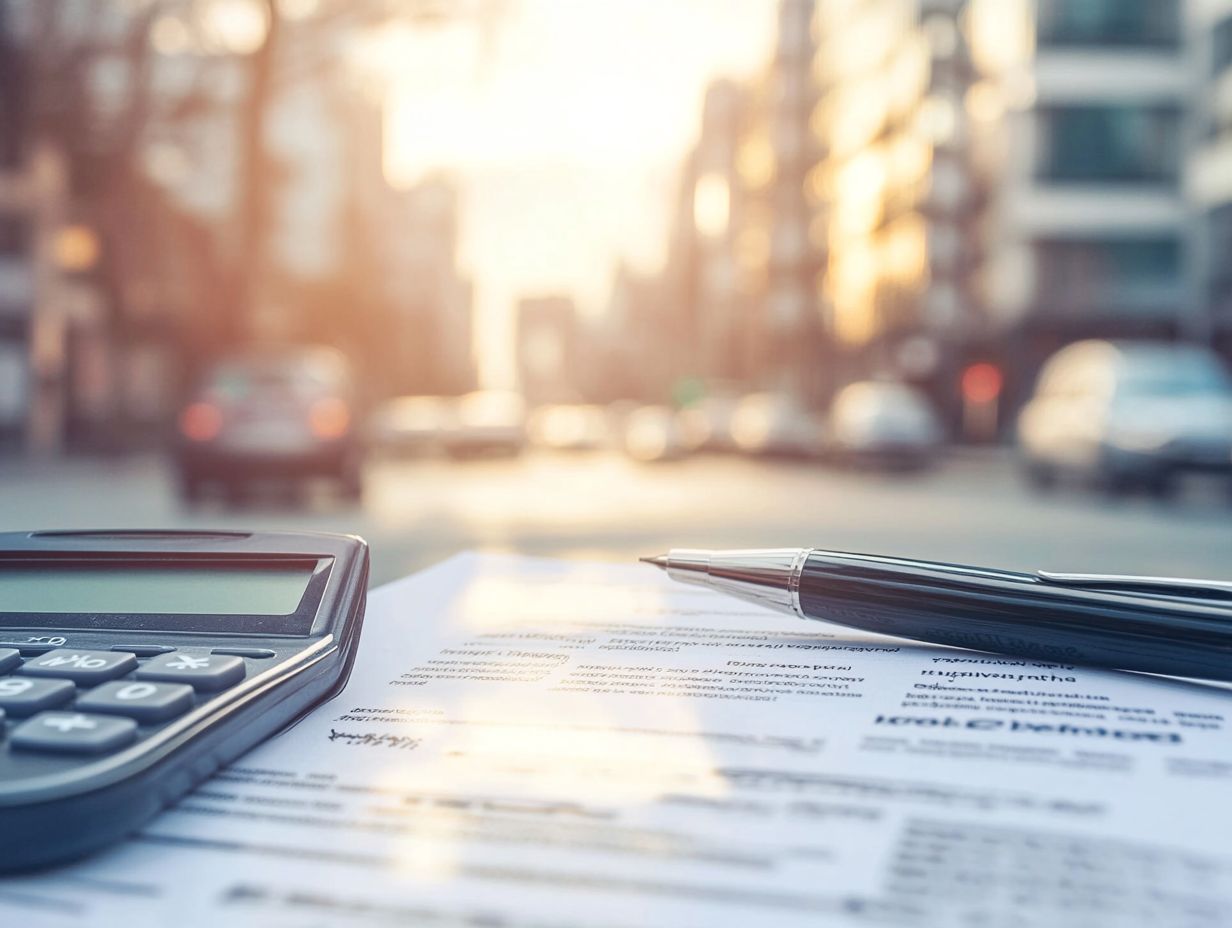Understanding Liability Coverage for High-Risk Drivers
Liability coverage is an important part of car insurance, especially for high-risk drivers who face unique challenges in securing adequate protection.
This article delves into the essence of liability coverage, highlighting its significance and the various types it includes, such as bodily injury and property damage liability. The article examines what affects coverage for high-risk drivers, including driving records and demographic information.
By the end of this exploration, you will be equipped to secure the right liability coverage and enjoy the peace of mind that comes with it.
Contents
- Key Takeaways:
- What is Liability Coverage?
- Types of Liability Coverage
- Factors that Affect Liability Coverage for High-Risk Drivers
- Driving Record
- How to Obtain Liability Coverage for High-Risk Drivers
- Benefits of Obtaining Liability Coverage
- Frequently Asked Questions
- What is liability coverage for high-risk drivers?
- Who is considered a high-risk driver?
- What does liability coverage for high-risk drivers include?
- How much liability coverage do I need as a high-risk driver?
- Can I reduce my premiums for liability coverage as a high-risk driver?
- What if I can’t find an insurance company to cover me as a high-risk driver?
Key Takeaways:

- Understanding liability coverage is crucial for high-risk drivers; it protects you in an accident.
- Factors like your driving record and age can influence the cost and availability of coverage.
- Having liability coverage fulfills legal requirements and offers peace of mind for you and others.
Definition and Common Characteristics
High-risk auto insurance is tailored for drivers who fall into the high-risk category due to factors like a poor driving record, multiple traffic violations, or serious incidents like DUI (Driving Under the Influence) or DWI (Driving While Intoxicated). This specialized coverage meets your unique needs and ensures compliance with state regulations while providing adequate protection.
It s vital for you to understand the common characteristics that define your situation. This often results in elevated premiums and limited coverage options from different insurance providers.
Your history of accidents, especially those causing injuries or significant property damage, plays a major role in categorizing you as high-risk. If you re a habitual offender with multiple speeding tickets or other infractions, expect tougher scrutiny from insurers, leading to increased rates. Additionally, drivers with DUI convictions face not only harsher penalties but also substantially higher auto insurance costs.
These factors increase your perceived risk, leading to higher premiums. Insurance companies do this to protect themselves from potential losses. Consequently, you might find your options limited to a handful of providers willing to offer coverage, underscoring the implications of your driving history.
What is Liability Coverage?
Liability coverage is an important part of any auto insurance policy, protecting you from money problems if you are deemed responsible for an accident or injury to another party. This coverage not only ensures compliance with state regulations but also gives you the reassurance of being protected against potential lawsuits.
It’s crucial for every driver to understand the intricacies of liability coverage, especially those considered high-risk, as it can significantly impact your insurance costs and available options. For high-risk drivers, knowing what to know about SR-22 insurance is particularly important.
Explanation of Coverage and Importance
Understanding liability coverage is essential for you as a driver; it serves as your financial safety net in the event of at-fault accidents. It protects you from hefty claims, ensuring you can drive with peace of mind.
This type of coverage is particularly vital in guarding against potential financial turmoil resulting from medical expenses and property damage claims made by injured parties. Reliable liability coverage helps manage unforeseen costs and plays a critical role in ensuring claims satisfaction, assisting in settling disputes efficiently.
If you re classified as a high-risk driver, lacking adequate liability coverage can lead to soaring insurance premiums. It s even more crucial for you to understand the importance of comprehensive protection. Without such coverage, the costs of an accident can spiral out of control, potentially jeopardizing your long-term financial stability.
Types of Liability Coverage
Liability coverage can be categorized into two main types: bodily injury liability and property damage liability. Both are crucial for protecting you from the financial fallout that can arise after an accident.
Factors that Affect Liability Coverage for High-Risk Drivers
Several factors play a crucial role in shaping liability coverage for high-risk drivers. Your driving record, the frequency of your traffic violations, and your overall driving habits are all essential elements in determining your risk classification and insurance rates.
Bodily Injury Liability

Bodily injury liability is an important part of your liability coverage, designed to help victims with medical expenses, lost wages, and other damages that arise from accidents where you, the insured driver, are considered at fault.
This type of coverage generally includes limits, which refer to the maximum amount your insurance can pay per person and per accident. For example, you might find a policy that covers $25,000 per person and $50,000 per accident, though these limits can fluctuate based on state regulations and your unique requirements.
It’s crucial for you, especially if you fall into a high-risk category due to your driving history or other factors, to ensure you have sufficient coverage. Falling short on limits could result in substantial out-of-pocket costs in the event of a serious accident, further exacerbating the already steep insurance premiums you may be facing.
By opting for higher bodily injury liability limits, you can safeguard both yourself and your financial future against unexpected accidents. Are you ready to protect your financial future?
Property Damage Liability
Property damage liability covers the expenses linked to damage to someone else’s property think vehicles or buildings when you’re found at fault in an accident.
This type of insurance is a vital shield, protecting you from potentially overwhelming financial repercussions stemming from claims related to your actions. The calculation of property damage liability usually depends on how extensive the damage is, with insurers assessing repair costs, loss in value, and replacement values.
Recognizing the importance of this coverage is essential, particularly for high-risk drivers who may encounter higher premiums. With different insurance providers offering a range of coverage options, it’s crucial for you to compare policies to secure the protection that meets your specific needs and risk profile. Don t wait until it s too late; assess your needs today!
Driving Record
A driver s record is among the most critical factors influencing liability coverage and insurance costs. It offers insurers valuable insights into your driving behavior and history of traffic violations.
For example, if you maintain a clean driving record, you could see a significant reduction in your insurance premiums. It signals to insurers that you re a lower risk. Conversely, if your record is marred by multiple violations or accidents, you ll be categorized as a high-risk driver, leading to inflated costs to offset the increased likelihood of future claims. High-risk drivers often face steep premiums and may even encounter difficulties securing coverage.
Take, for instance, someone who has accumulated several speeding tickets and been involved in accidents; not only do their premiums soar, but they might also risk having their policy canceled by certain insurers.
Therefore, keeping a clean driving record is essential not only for your safety on the road but also for managing your insurance expenses effectively.
Age and Gender
Age and gender are crucial demographic factors that insurance companies take into account when evaluating high-risk drivers and setting insurance rates. If you re a young driver, you may find yourself facing higher premiums due to statistical risk factors.
Research shows that drivers aged 16 to 24, especially males, are significantly more likely to be involved in accidents than their older counterparts. This risk translates to an average premium increase of 20-30% for this group. The Insurance Institute for Highway Safety reports that male drivers within this age range have a crash rate that is nearly double that of female drivers. Insurance providers rely on this data in their risk assessment models, balancing these demographic characteristics with your driving history and other personal information.
By grasping these trends, you can make more informed decisions about your coverage options.
Type of Vehicle

The type of vehicle you choose to drive significantly influences your liability coverage as a high-risk driver. Cars equipped with advanced safety features often lead to lower insurance costs compared to those lacking such innovations.
This connection exists because insurers view vehicles with modern safety technologies like anti-lock brakes, adaptive cruise control, and lane-keeping assistance as less likely to be involved in accidents. The age of your vehicle also plays a crucial role. Newer models typically come with enhanced safety features and reliability, which can further lower your premiums.
For high-risk drivers, selecting a car that falls into a lower risk classification boosts your chances of securing better rates and encourages safer driving habits. This ultimately leads to a decrease in your overall insurance expenses.
How to Obtain Liability Coverage for High-Risk Drivers
Securing liability coverage for high-risk drivers requires a thoughtful approach. You’ll need to explore a range of insurance options. It’s wise to seek multiple quotes and partner with independent agents who can help you find the policy that best meets your unique needs, including understanding liability coverage.
Insurance Options and Requirements
High-risk drivers like you have a variety of insurance options available, each with specific coverage requirements that you must understand to comply with state regulations.
Understanding these options is essential because insurance providers typically evaluate factors such as your driving history, age, and type of vehicle when determining the right coverage. Some standard policies, like liability insurance, are mandatory in most states.
You might also want to consider additional coverage options like collision and comprehensive insurance. These can provide extra protection against potential losses.
As a high-risk driver, it s worth looking into non-standard insurance providers that tailor their offerings to meet your specific needs. Additionally, exploring umbrella policies can enhance your liability protection, ensuring you have a well-rounded strategy for safeguarding yourself on the road.
Benefits of Obtaining Liability Coverage
Securing liability coverage provides substantial advantages for high-risk drivers, including financial protection against the expenses tied to at-fault accidents. Understanding coverage for unlicensed drivers can further enhance this protection.
It also offers reassurance from being compliant with state regulations, allowing you to drive with confidence and peace of mind.
Protection and Peace of Mind
With liability coverage, you can drive confidently and enjoy your adventures knowing you re protected! This essential safety net enhances your overall driving experience.
It allows you to concentrate on the journey ahead rather than being preoccupied with potential costs from unforeseen incidents.
When unexpected events occur, knowing that your liability coverage can shoulder the financial burden significantly eases anxiety. Pair that with the claims satisfaction of a trustworthy insurance provider, and you have an added layer of security, assuring you that your concerns will be handled promptly and fairly.
With such protection, your driving journey transforms into a more enjoyable and stress-free adventure.
Frequently Asked Questions

What is liability coverage for high-risk drivers?
Liability coverage for high-risk drivers is a type of insurance that protects you financially if you are at fault in an accident. It covers the costs of damages and injuries to others involved in the accident, and understanding uninsured motorist coverage for high-risk drivers is equally important to ensure comprehensive protection.
Who is considered a high-risk driver?
A high-risk driver is typically someone who has a history of traffic violations, accidents, or DUI convictions. Insurance companies view them as a higher risk to insure, which is why their premiums are usually higher.
What does liability coverage for high-risk drivers include?
Liability coverage for high-risk drivers typically includes bodily injury liability and property damage liability. Sometimes, it also covers personal injury protection. These coverages help you if you injure someone or damage their property in an accident.
How much liability coverage do I need as a high-risk driver?
The amount you need depends on your situation. It’s wise to have enough coverage to protect your assets in case of a lawsuit. Discuss your needs with an insurance agent.
You can reduce your premiums in several ways. Taking defensive driving courses, maintaining a good driving record, and choosing a higher deductible are effective strategies. Compare quotes from different insurance companies to find the best rate.
What if I can’t find an insurance company to cover me as a high-risk driver?
If you can’t find coverage, consider a state assigned risk plan. This should be a last resort, as it often comes with higher premiums. Finding the right insurance is crucial; don’t wait too long to improve your driving record!






